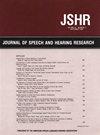Decomposing Variation in Vocabulary and Listening Comprehension Task Performance in Spanish and English Into Person, Ecological, and Assessment Differences for Spanish-English Bilingual Children in the United States.
IF 2.2
2区 医学
Q1 AUDIOLOGY & SPEECH-LANGUAGE PATHOLOGY
Journal of Speech Language and Hearing Research
Pub Date : 2024-09-18
DOI:10.1044/2024_jslhr-23-00702
引用次数: 0
Abstract
PURPOSE We investigated the contributions of person, ecological, and assessment characteristics to one's performance on vocabulary and listening comprehension tasks in English and Spanish. Person characteristics included English learner status, ecological characteristics included instructional program enrollment (bilingual vs. English immersion) and poverty status, and assessment characteristics included the language of assessment (Spanish vs. English) and linguistic grain size (vocabulary vs. listening comprehension). METHOD Data were from 208 Spanish-English emergent bilingual children in Grade 1 in the United States and were analyzed using explanatory item response models. RESULTS Substantial variance in the tasks across both languages was attributable to the random effects of assessment/item (74%) and person (26%). English learner status was a significant student predictor of language performance, and the instructional program was a significant ecological predictor of language performance. Regarding assessment characteristics, both the language of assessment and linguistic grain size explained the variance in performance. There were no differences in performance on English assessments between children in the Spanish-English bilingual program and children in the English immersion program. However, on the Spanish tasks, children in the bilingual program outperformed their peers in the English immersion program. CONCLUSION These findings highlight the importance of considering not only person/child characteristics but also ecological and assessment characteristics for Spanish-English bilingual children's performance on oral language tasks. SUPPLEMENTAL MATERIAL https://doi.org/10.23641/asha.26972749.将美国西英双语儿童在西班牙语和英语词汇和听力理解任务中的表现差异分解为个人差异、生态差异和评估差异。
目的我们研究了个人、生态和评估特征对英语和西班牙语词汇和听力理解任务成绩的影响。个人特征包括英语学习者身份,生态特征包括教学计划注册情况(双语与英语浸入式)和贫困状况,评估特征包括评估语言(西班牙语与英语)和语言粒度(词汇与听力理解)。数据来自美国 208 名一年级的西班牙语-英语新兴双语儿童,并使用解释性项目反应模型进行了分析。结果两种语言任务的巨大差异可归因于评估/项目(74%)和人(26%)的随机效应。)英语学习者身份是预测语言成绩的重要学生因素,而教学计划则是预测语言成绩的重要生态因素。在评估特征方面,评估语言和语言粒度都能解释成绩的差异。参加西班牙语-英语双语项目的儿童和参加英语浸入式项目的儿童在英语评估中的表现没有差异。结论:这些研究结果突出表明,对于西班牙语-英语双语儿童的口语任务表现,不仅要考虑个人/儿童特征,还要考虑生态和评估特征。
本文章由计算机程序翻译,如有差异,请以英文原文为准。
求助全文
约1分钟内获得全文
求助全文
来源期刊

Journal of Speech Language and Hearing Research
AUDIOLOGY & SPEECH-LANGUAGE PATHOLOGY-REHABILITATION
CiteScore
4.10
自引率
19.20%
发文量
538
审稿时长
4-8 weeks
期刊介绍:
Mission: JSLHR publishes peer-reviewed research and other scholarly articles on the normal and disordered processes in speech, language, hearing, and related areas such as cognition, oral-motor function, and swallowing. The journal is an international outlet for both basic research on communication processes and clinical research pertaining to screening, diagnosis, and management of communication disorders as well as the etiologies and characteristics of these disorders. JSLHR seeks to advance evidence-based practice by disseminating the results of new studies as well as providing a forum for critical reviews and meta-analyses of previously published work.
Scope: The broad field of communication sciences and disorders, including speech production and perception; anatomy and physiology of speech and voice; genetics, biomechanics, and other basic sciences pertaining to human communication; mastication and swallowing; speech disorders; voice disorders; development of speech, language, or hearing in children; normal language processes; language disorders; disorders of hearing and balance; psychoacoustics; and anatomy and physiology of hearing.
 求助内容:
求助内容: 应助结果提醒方式:
应助结果提醒方式:


